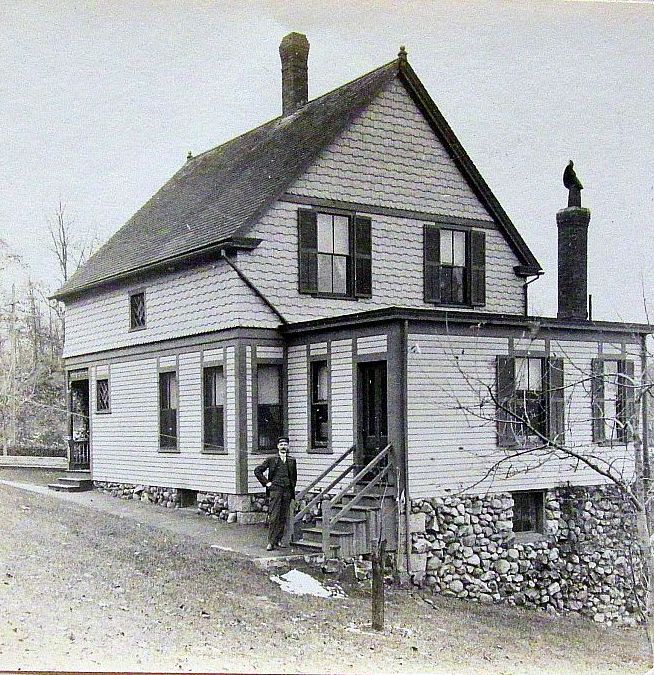
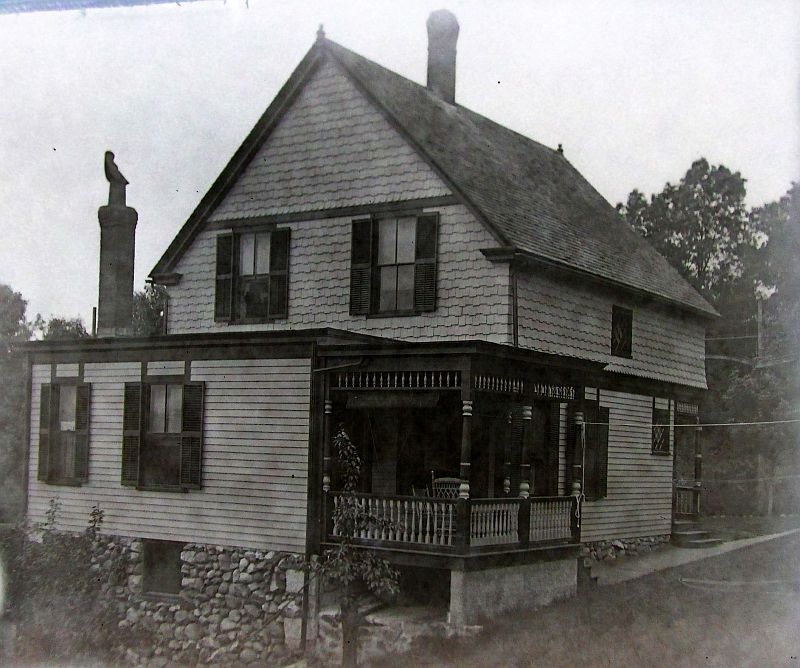
The photos above of the house at 54 Freedom Street where Hester Chilson lived from the age of 15 to her death at 100 were taken by her foster father, Edwin Darling. Click here to see more of Darling’s pictures.
Memories of Hester Chilson
In 1912, when I was seven, my father took our family to the dedication of the General Draper statue in Milford. We lived in Mendon at that time, and my father worked at a second-hand shop in Milford. He took us there in a horse-drawn wagon called a democrat. A democrat had a seat in the front for the driver and removable seats in the back that slid in and out on metal tracks He parked the horse and wagon on South Bow Street and we walked to the Draper Park. The general’s daughter, Margaret, was all dressed up. This was a few years before she became Princess Boncompagni. She pulled a rope to unveil the statue but the covering didn’t come down as easily as it was supposed to. They had to work at it a bit to get it down.
I came to Hopedale on November 20, 1920. I was about 15. My father had died and I came to live with the Darlings. They had always wanted children.
What I remember most was my Christmas stocking. There would be an orange in it; a big California orange.
Mr. and Mrs. Darling built the house here [54 Freedom Street] in 1893. She remembered going down to where the park is now and picking cranberries there.
Mr. Darling was a selectman from 1895 to 1926. As far as I can figure, he was secretary of the town. He kept note cards that appeared to be a record of the town. Once a year the selectmen had to walk the bounds of the town. When Heman Hersey came down with smallpox [in 1901] the selectmen had to find a place to put him where he could be quarantined. They got a place on West Street that became known as the Pest House for him. He worked at Patrick’s and he recovered and was able to go back to work. Eventually he moved to Mendon. His brother, Frank, also worked for Patrick’s, and lived in the duplex next door to us.
The strike at Drapers in 1913 was a very difficult time for people in town. Mrs. Darling’s parents lived three houses down the street [the house on Freedom Street across from Prospect Street, bordering the park] and she’d go to see them every day. During the strike she carried a derringer with her when she went. The men carried billy clubs.
Mr. Darling, Mr. Stimpson and Mr. Butterworth were the trustees of the Community House. It was built by the Casper Construction Company. Helen Draper, George Albert Draper’s daughter, left $5,000 for a swimming pool at the Community House, but it turned out that this wasn’t enough. (According to a newspaper article about Helen’s will, after her death in 1933, she left $400,000 for the Community House, of which $100,000 was to be used to build a pool. Click here to see a Milford News article on her will. It’s near the bottom of the page on her father.) She was tall and stately looking and was friendly with Mrs. Stimson.
My husband Clarence went to work for Casey’s [hardware] in Milford when he got out of high school in 1925. In the 1930s he went to work for (Steve?) Reynolds in Milford. Reynolds sold radios and eventually sold Grunow refrigerators. He sent Clarence to Boston for a course on refrigerator repair. Reynolds told Clarence that if we wanted to buy a refrigerator from him, we could pay for it on the installment plan. We decided we’d get one. Up until then we had an icebox and got ice from the Hopedale Coal and Ice Company. The ice was delivered in a wagon pulled by two beautiful black horses. Mr. Ward and Mr. Cole were the deliverymen. When Clarence told them that we were getting a refrigerator and wouldn’t be needing ice anymore, Mr. Ward was quite upset and thoroughly disgusted. I can see him now. He was really mad. He told us an electric refrigerator was a terrible thing and would ruin our health. The Grunows were supposed to be better than the Frigidaires but I don’t think Reynolds sold too many of them.
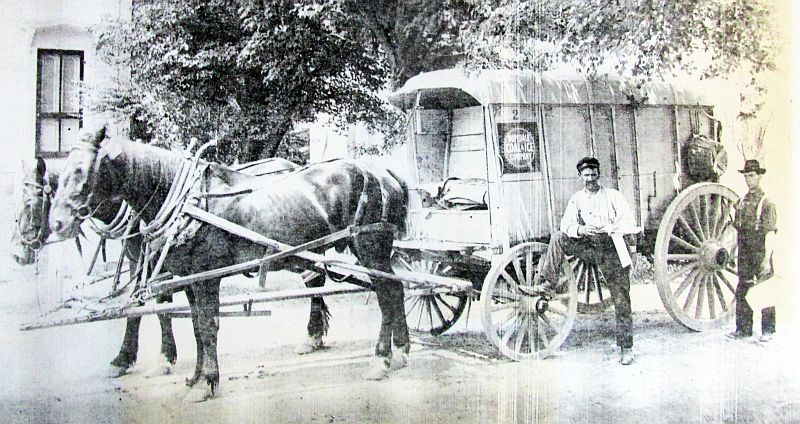
Clarence started his own radio repair business out of his bedroom on South Main Street. Later he did radio and tv repair out of our house here on Freedom Street. He made our first tv. I think that was in 1948. It had a twelve and a half inch screen. He had put the yoke on wrong and when the first program came on, we watched wrestling from New York and it was upside down. Mr. Goss, our pastor was here and we all got quite a kick out of it. When the Howdy Doody show started all the kids from the neighborhood would come in here to watch. We’d have about twenty of them here. Clarence operated his radio and tv repair business out of our house here on Freedom Street for many years.
Harriet Sornberger was the librarian for about thirty years in the first half of the twentieth century. I think she went to the Unitarian Church, but she liked to hear the minister at the Pine Street Baptist Church in Milford where we belonged. Clarence had a recorder and he used to record the service. He’d bring the recorder down to Harriet’s house on the corner of Dutcher and Hope streets on Sunday afternoons and they’d listen to the service.
I remember Charlie Merrill coming here one time to pick up his radio that Clarence had fixed. He was quite upset. A house on Adin Street [the one next to the high school] had been left to the town with the intention that it was to be used by the Historical Society as museum. He had been told that wasn’t going to happen and he felt quite bad about it. He had just come from the library and he said there were many things in the cellar there that should be on display at that house..
Georgiena Bailey was the last baby to be born in the Old House and she was quite proud of that fact. She was probably in her eighties when I knew her. People helped her out and brought food to her. Anna Bancroft “took responsibility” for her. Mrs. Darling would often bring her something and sit and talk with her. Sometimes when she couldn’t go, she’d send me. I believe she died in the 1920s.
I remember Officer Louis Barrows. He worked nights. Officer Walter Drisko worked days. He had a motorcycle and he insisted on a sidecar.
Walter Durgin was a policeman and a game warden. He’d tell kids about birds and trees. He was awfully nice.
I recall two icehouses. One was where the Gannetts live, and the other, owned by Henry Patrick, was near where the bathhouse is now. When the Patrick icehouse was dismantled, the wood was used to build the duplex right next to our house. [56 – 58 Freedom Street] Patrick owned it and it was rented out to his employees. [According to the Park Department website, however, the wood was going to be used to build the bathhouse but it burned down before that was accomplished.]
I remember Beal’s Shoe Store. William Beal owned it. They repaired and sold shoes there.
Mrs. Butterworth had an electric car.
People worked from six A.M. to six P.M. Monday through Friday at Drapers. They’d have one hour for lunch. They worked a half day on Saturday.
The Sneidermans operated a little grocery store on Freedom Street at the five way intersection. We bought a lot there. Their nephew would come around in the morning to take orders and they’d deliver in the afternoon. Their son, Eddie, had had polio and walked with crutches. They’d push him down to school every day in a cart.
**************************************
Hester observed her 100th birthday in September 2005. She was still living at her home on Freedom Street at the time, and enjoyed the visits of family and friends who dropped in that day. She died two months later, on the day before Thanksgiving.
Photos by Edwin Darling Memories Menu HOME
TV Image Received In Hopedale
HOPEDALE, June 1 [1948] Atmospheric conditions are credited with the clear and distinct television reception on a recent evening when four stations, three from New York and one from Philadelphia, were brought into the home of Clarence E. Chilson, Freedom Street.
Mr. Chilson, well-known radio technician explained the unusual situation as due to temperature inversion, which to the average person means cool ground and warm air overhead.
If the inclement wet and humid weather was good for something it is news to everyone and should help to raise the morale.
Mr. Chilson has been studying television in his spare time for several years. He was the first person in this area to receive a TV image. His home-constructed set brought in a station in 1941.
The present set is another that he constructed himself. On Friday night he and several friends were able to witness a boxing match from Madison Square Garden for nearly two hours, without interruption. In addition, Mr. Chilson receives the test patterns daily, now being sent out from the Boston station. The Milford Daily News
The newspaper article didn’t mention one little problem the viewers had while watching the boxing match. The yoke, a part that went around the picture tube, had been put on wrong and the picture was upside down.
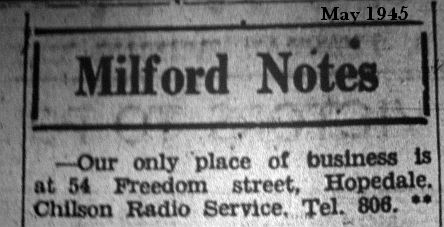
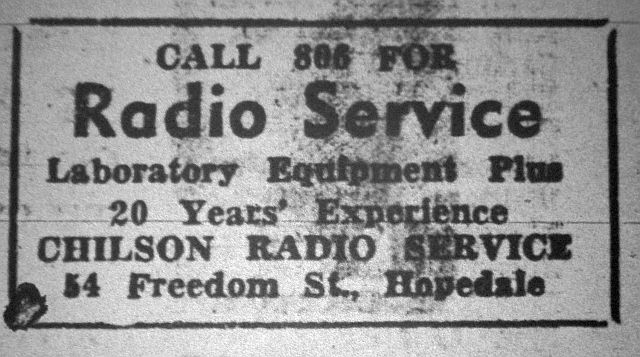
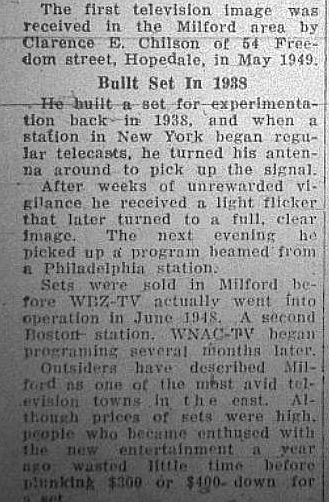

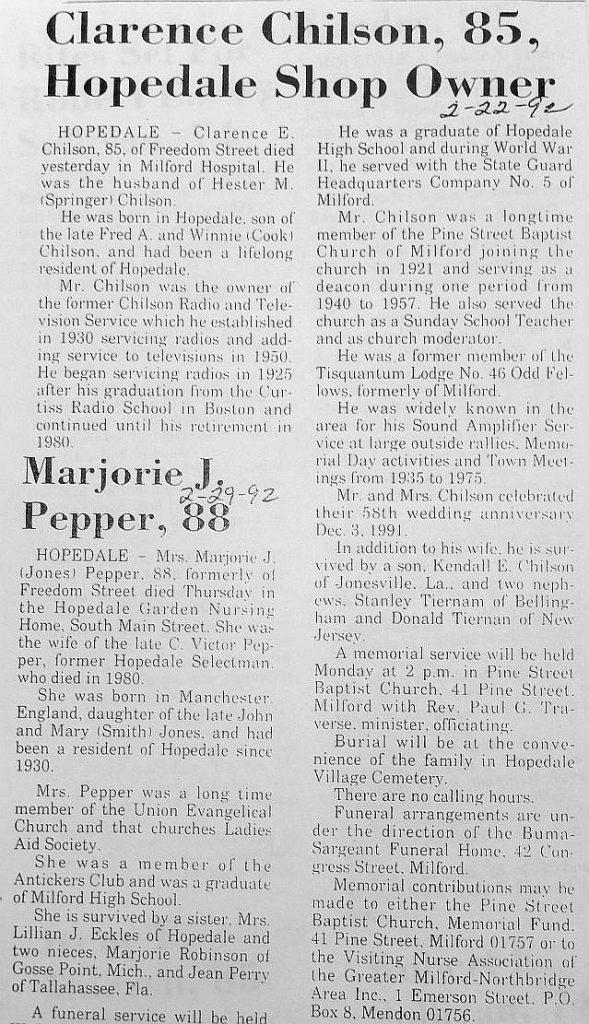


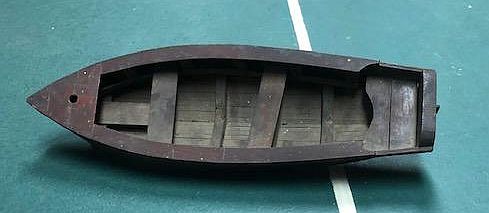

This model boat was made by Edwin Darling for Wesley Hixon.